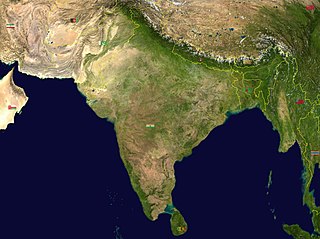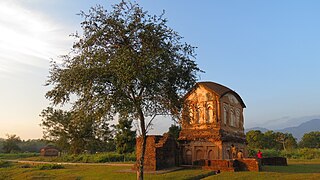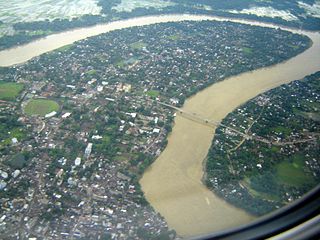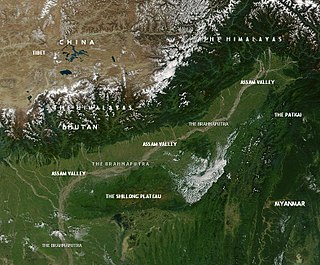
India is situated north of the equator between 8°4' north to 37°6' north latitude and 68°7' east to 97°25' east longitude. It is the seventh-largest country in the world, with a total area of 3,287,263 square kilometres (1,269,219 sq mi). India measures 3,214 km (1,997 mi) from north to south and 2,933 km (1,822 mi) from east to west. It has a land frontier of 15,200 km (9,445 mi) and a coastline of 7,516.6 km (4,671 mi).

The Himalayas, or Himalaya, is a mountain range in Asia, separating the plains of the Indian subcontinent from the Tibetan Plateau. The range has some of the Earth's highest peaks, including the very highest, Mount Everest; over 100 peaks exceeding elevations of 7,200 m (23,600 ft) above sea level lie in the Himalayas.

Arunachal Pradesh is a state in Northeastern India. It was formed from the erstwhile North-East Frontier Agency (NEFA) region, and became a state on 20 February 1987. Itanagar is the state capital and its largest town.

The Brahmaputra is a trans-boundary river which flows through Tibet (China), Northeastern India, and Bangladesh. It is also known as the Yarlung Tsangpo in Tibetan, the Siang/Dihang River in Arunachali, Luit and Brahmaputra in Assamese, Brahmaputro in Bengali in India and Jamuna River in Bengali in Bangladesh. It is the 9th largest river in the world by discharge, and the 15th longest.

Northeast India (officially the North Eastern Region(NER)) is the easternmost region of India representing both a geographic and political administrative division of the country. It comprises eight states—Arunachal Pradesh, Assam, Manipur, Meghalaya, Mizoram, Nagaland and Tripura (commonly known as the "Seven Sisters"), and the "brother" state Sikkim.

Kohima is the capital of the Indian state of Nagaland. With a resident population of almost 100,000, it is the second largest city in the state. Kohima constitutes both a district and a municipality. The municipality covers 20 km2 (7.7 sq mi). The city lies on the foothills of Japfü section of the Barail Range located south of the District and has an average elevation of 1,261 metres.

Cachardistrict is an administrative district in the state of Assam in India. After independence, the undivided Cachar district was split into four districts in Assam: Dima Hasao district, and Cachar district alongside Hailakandi and Karimganj.

The Barak River flows 900 kilometres (560 mi) through the states of Manipur, Nagaland, Mizoram and Assam in India. Further it enters Bangladesh where it bifurcates into the Surma river and the Kushiyara river which converges again to become the Meghna river before forming the Ganges Delta with the Ganga and the Brahmaputra rivers and flowing into the Bay of Bengal. Of its length 524 km (326 mi) is in India, 31 km (19 mi) on the Indo–Bangladesh border and the rest is in Bangladesh. The upper part of its navigable part is in India — 121 km (75 mi) between Lakhipur and Bhanga, declared as National Waterway 6, (NW-6) since the year 2016. It drains a basin of 52,000 km2 (20,000 sq mi), of which 41,723 km2 (16,109 sq mi) lies in India, 1.38% (rounded) of the country. The water and banks host or are visited by a wide variety of flora and fauna.
Badarpur is a town and a town area committee in Karimganj district in the state of Assam, India. Badarpur. Together with adjacent Badarpur Railway Town, it forms the Badarpur Urban Area, one of two notified urban areas in the district. The area is also popularly known as "Gateway to the Barak Valley" of Assam. Badarpur was a part of Karimganj district till 31st December 2022.

This article discusses the geological origin, geomorphic characteristics, and climate of the northeastern Indian state of Assam. Extending from 89° 42′ E to 96° E longitude and 24° 8′ N to 28° 2′ N latitude, it has an area of 78,438 km2, similar to that of Ireland or Austria.
Mizoram is a land of rolling hills, valleys, rivers and lakes in Northeast India. As many as 21 major hills ranges or peaks of different heights run through the length and breadth of the state, with plains scattered here and there. The average height of the hills to the west of the state are about 1,000 metres. These gradually rise up to 1,300 metres to the east. Some areas, however, have higher ranges which go up to a height of over 2,000 metres.
BARAIL Wildlife Sanctuary is located in the southern part of Assam, India, in Cachar district and lies between 24°55΄53΄΄-25°05΄52΄΄ N latitude and 92°27΄40΄΄-93°04΄30΄΄ E longitude. The Dima Hasao part of Barail is not part of this sanctuary. The altitude ranges between 55–1500 m above mean sea level. It spreads over 326.24 km2. The annual average rainfall and temperature range from 2500–4000 mm and 9.2 °C to 36.2 °C respectively; the Humidity varies from 62% to 83%. Field works in Barail area proposed as a national park/sanctuary in 1980s.

Northeast India consists of the eight states Arunachal Pradesh, Assam, Manipur, Meghalaya, Mizoram, Nagaland, Sikkim and Tripura. Tourism in this area is based around the unique Himalayan landscape and culture distinct from the rest of India.

Arunachal Pradesh is primarily a hilly tract nestled in the foothills of the Himalayas in northeast India. It is spread over an area of 83,743 km2 (32,333 sq mi). 98% of the geographical area is land out of which 80% is forest cover; 2% is water. River systems in the region, including those from the higher Himalayas and Patkoi and Arakan Ranges, eventually drain into the Brahmaputra River.
Khonoma Nature Conservation and Tragopan Sanctuary or KNCTS is a conservation reserve and a protected area in the Kohima District of the state of Nagaland in India. It is about 18 kilometres (11 mi) west of the capital of Nagaland, Kohima. The total area notified under this park is around 25 square kilometres (9.7 sq mi); some of villages and hamlets are adjacent to this park: Khonoma, Mezoma and Dzüleke. The sanctuary is home to several endangered mammal species, including the clouded leopard, Asiatic black bear, and hoolock gibbon, as well as over 300 avian species.
Mount Tempü is a peak of the Barail Range rising at the mountainous border of the Indian states of Manipur and Nagaland. With a height of 2994 m above sea level, Tempü is the highest peak in present day Indian state of Manipur and the second highest in the Barail Range.

The Jatinga River is a north bank tributary of the Barak River in the Indian state of Assam. The river originates from Barail hill range in the village Jatinga at Dima Hasao district of Assam. The Jatinga then flows through the western boundary of the Barail Wildlife Sanctuary and then join several other small tributaries like Chhotarekha, Bororekha, Daku, Chhota Lokha, Dimru, Ditokcherra, Kayang, Dolu, Badri etc before its confluence with the Barak river at Jatingamukh below Barkhola village near Chandpur of Cachar District.
Mount Japfü, is a mountain peak of the Barail Range, located in Kohima District of Nagaland in India, about 15 kilometres (9 mi) south of Kohima, the capital of Nagaland. With a summit elevation of 3,048 m (10,000 ft), it is the fourth highest mountain in the Indian state of Nagaland and the highest in the Barail Range.












